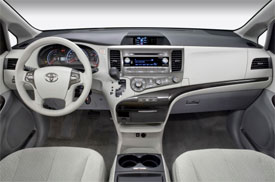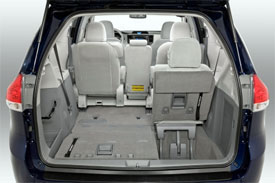2011 Toyota Sienna
When Toyota replaced the oddball Previa with the front-drive Sienna for 1998, it staked a firmer foothold in the minivan market. The redesigned 2004 Sienna added all-wheel-drive as an option, making it a true alternative to popular SUVs. Now, for 2011, the Sienna is all-new again, and it’s crossover utilities that dominate the family scene. So, let’s see if the new Sienna can stand its ground.
The 2011 Toyota Sienna minivan starts off by standing its ground on size. Its 119.3-inch wheelbase is the same as its predecessor. But it is a few fractions of an inch wider and shorter overall, much of which can be attributed to its all-new styling, penned entirely at Toyota’s Calty studio in Newport Beach, California. And, Calty has given Sienna a fairly aggressive version of the corporate notched hood, above a sharply tapered trapezoidal grille. Narrow, dramatically swept-back headlights are set high in a pair of bulging front fenders.
From there, the Sienna’s greenhouse follows the slight curvature of character lines drawn high on its flanks. Unmistakable Venza-like taillights wrap around under the D-pillars.
 Styling cues vary by trim. The sporty-looking SE’s mesh grille, deep splitter, rocker panels, and smoked taillights set it apart from the rest of the clean but much more pedestrian Sienna lineup. A selection of standard alloy wheels range from 17 to 19 inches in diameter.
Styling cues vary by trim. The sporty-looking SE’s mesh grille, deep splitter, rocker panels, and smoked taillights set it apart from the rest of the clean but much more pedestrian Sienna lineup. A selection of standard alloy wheels range from 17 to 19 inches in diameter.
But while a dose of exterior excitement is fine, the focal point of every minivan is the interior. To that end, the 2011 Sienna fills slightly bigger shoes than last year, with two inches added to interior length. It’s also wider inside, and the now flowing dash has a less pronounced, more integrated center stack to make it feel even roomier.
The front seat passengers are treated to a funky asymmetrical trim swoosh separating two glove boxes, and the driver will find a more upscale instrument cluster with standard ECO driving indicator in the multifunction liquid crystal screen. A full complement of airbags includes one for the driver’s knee.
Standards include tri-zone climate, CD stereo with aux input, up to a dozen cup holders, and dual sliding doors with power windows. Ascend the trim levels, and amenities like wood trim, voice command navigation, and a novel sliding center console are available.
Unlike Chrysler’s minivans, the Sienna’s second row seats don’t fold into the floor. They’re heavy, but are removable. Seven-passenger models have twin captain’s chairs. In Limited trim they recline. The eight-seater features a split bench with a stowable center section. The captain’s chairs have 23 inches of fore/aft travel and seat cushions that tip up, allowing easy access to the third row. There, the 60/40 split bench is placed two inches further back than before for adult-size legroom.
The optional rear entertainment system has a 16.4-inch screen that can display two inputs—like a movie and a game—at the same time. Unlike Chrysler vans, however, satellite TV is not available.
 Cargo volume behind the upright third seat is good at 39.1 cubic feet. Drop the third row and cargo volume goes to 87.1 cubic feet. With the second row removed, cargo volume grows to 150 cubic feet, or more than all rivals.
Cargo volume behind the upright third seat is good at 39.1 cubic feet. Drop the third row and cargo volume goes to 87.1 cubic feet. With the second row removed, cargo volume grows to 150 cubic feet, or more than all rivals.
Sienna continues as the only minivan available with all-wheel-drive. For 2011, it returns as an option on V6-powered LE, XLE, and Limited models.
Base power comes from the Sienna's first four cylinder. The 2.7-liter, shared with Highlander and Venza, rates 187 horsepower and 186 pound-feet of torque. The carryover 3.5-liter V6 rates 266 horsepower and 245 pound-feet of torque. A new six-speed transmission with sequential shift handles gear changes for both motors. With the V6, Sienna can tow 3,500 pounds.
Suspension hardware is traditional minivan, strut front and a beam axle rear. But careful retuning, stability control, and new electric power steering provide Sienna an unusually tactile driving experience, especially the SE, which gets treated to an even sportier setup. All-disc ABS brakes are standard.
While the four-cylinder does strain a little under heavy loads, its Government Fuel Economy ratings of 19 city/26 highway are the best in its class. The front drive V6 rates 18 city/24 highway, dropping to 16 city/22 highway with all-wheel-drive. All Siennas run on regular gas.
When it goes on sale later this spring, Sienna prices will start slightly lower than last year at $25,010. The V6 starts at $26,250, and can climb to an eye-popping $40,520 for an all-wheel drive Limited.
That said, the 2011 Toyota Sienna has something for every minivan taste— a more economical four-cylinder, class-exclusive all-wheel drive, and the nicely sporty SE model. So, not only can this highly versatile vehicle stand its ground, it's likely to make a few more suburbanites think twice about buying a big CUV.Specifications
- Engine: 2.7-Liter Four Cylinder
- Horsepower: 187
- Torque: 186 Lb Feet
- EPA: 19 MPG City/ 26 MPG Highway
2025 Porsche Taycan Turbo GT
It’s A Turbo GT With No Turbos Or Even An Engine
In an era when even mass market EVs have mind-bending acceleration, how do performance-minded brands such as Porsche stand out? Well, you take things to an even higher level of road-going insanity. Hold on for this one! The Porsche Taycan Turbo GT just changed the game again.
When the original Porsche Taycan arrived for 2020, it did not disappoint. We blasted the Turbo S version to 60 in 2.8 seconds and hustled that hefty Hoss around Roebling Road Raceway with 911-like proficiency. None of that was enough for Porsche. So, for 2025, the Taycan gets more range, more style, more tech, and of course it does it all faster than before too. And that’s before we even get to this Porsche Taycan Turbo GT which is new to the lineup.
For our return trip to Roebling Road, there was a threat of a major winter storm about to impact our track time, so we wasted none of it, hitting the track early and often. And it’s still amazing how this big battery on wheels can feel so Porsche like. No other brand has been able to accomplish a similar feat. We laud BMW for even coming close with the i4, but here you get the full capable and confident Porsche experience; even the brakes feel incredibly natural and powerful, ceramic brakes are standard with the Turbo GT.
Having said that, it remains a very heavy vehicle, so while you’re hustling it around the track it does tend to feel more like work than fun. Many EVs dial back the power as soon as you get up to speed, but here in the Turbo GT, it never seemed to let up, building to the point we reached over 170 mph on Roebling’s front straight, and the way it powers out of corners is otherworldly.
Now, while it does absolutely shred on a racetrack, it really feels best just high-speed sweeping your way through life on some scenic roads through the countryside. This Turbo GT’s 760-kW dual-motor setup cranks out 1,019 horsepower and 914 lb-ft of torque with Launch Control, which allows for sprinting to 60 in 2.2 seconds and clearing the quarter-mile in less than 10. But alas, that winter storm arrived and covered the track in snow before we got a chance to verify that.
You get the full capable and confident Porsche experience.
All Taycans get a new rear motor for ’25, along with updated software and improvements to the cooling system. And guess what? It charges faster too, now accepting up to 320 kW, getting it to 80% in as little as 18 minutes. There’s a 30% boost to the energy capture from regen braking as well, now up to 400 kW. What the Taycan desperately needed was more range, because who wants all this fun to ever stop; and it has been increased by as much as 35% throughout the lineup, now delivering as many as 318 miles; 276 for this Turbo GT.
The Turbo GT features a unique front splitter and active rear spoiler, but all Taycans get revised styling for ’25 including upgraded lighting and a revised front clip that both improves aerodynamics and accentuates the Taycan’s substantial width. All wheels have been aerodynamically optimized as well.
Things inside look mostly the same, but they have improved the functionality of their multimedia setup, moved some controls around, and provided more standard content. It’s a borderline luxury car experience as far as amenities and tech go, yet it still has a purposeful feel to it; and whether things are covered in Race-Tex or real leather everything looks and feels great. Gauges are of course all virtual now, but they can still have a traditional look if you prefer. You really have to duck down to get into the rear seats, but space is plentiful; and with a pair of trunks, there’s abundant luggage space too.
Using 41 kilowatts of electricity for every 100 miles, the Turbo GT earns a fair Efficiency Rating. There are now more options than ever across the Taycan lineup, and that’s even before you even get to Cross Turismos and Sport Turismos. So, while this Turbo GT may cost $231,995 to start, you can get largely the same experience for as little as $101,395 for a base Taycan.
The 2025 Porsche Taycan Turbo GT is more than just a fantastic EV; it’s a great car period, and even a terrific Porsche. With the recently released Macan Electric SUV and the upcoming Boxster and Cayman EVs, more than any other brand, Porsche is giving us reasons not to fear the electrified future.
Specifications
As Tested
- Motor Setup: Dual Motor
- Battery Size: 105 kWh
- EPA Range: up to 276 miles
- Horsepower: 1,019
- Torque: 914 lb-ft
- 0-60 mph (est.): 2.2 seconds




































